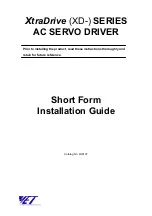
Logosol Absolute Positioning Servo Drive LS-173AP
Doc # 712173008 / Rev. 1.06, 05/09/2002
Logosol, Inc.
••
1155 Tasman Drive
••
Sunnyvale, CA 94089 Tel: (408) 744-0974
••
www.logosolinc.com 15
Brake Output
Brake is released (brake output is “on”) when Power_on (bit3 of
Status byte
) and Pic_ae (bit0
of
Stop
command data byte) are set to 1.
Brake Output
Brake will be engaged (Brake output is “off”) if:
-
STP IN is open;
-
Overvoltage;
Overcurrent;
-
Motor short;
-
Overheat;
-
Position error exceeds the position error limit.
Note:
For additional information refer to
Status bits and LED
,
Status byte and Auxiliary status
byte
and
Stop
command description, sections of this document. If Power Driver is OK, brake
will be released after Pic_ae 0 to 1 transition.
Dip Switch
Dip switch is used for setting overcurrent limit and terminator control (refer to
Overcurrent DIP
Switch Setting
of
Safety Features
section of this document) Two of switches ,T-in and T-out,
are used for connecting terminators to receive and transmit lines. SW-1 and SW-2 are factory
reserved and must be set to ON.
Serial Command Interface
Serial communication with the LS-173AP drives adheres to a full-duplex (4 wire) 8 bit
asynchronous protocol with one start bit, followed by 8 data bits (lsb first), followed by a single
stop bit.
The communication protocol of the LS-173AP also supports a full-duplex multi-drop RS-485
interface that allows multiple LS-173AP
Absolute Positioning Servo Drives to be controlled
over a single RS-485 port. In this case, the host sends commands over its RS-485 transmit
line and receives all status data back over the shared RS-485 receive line.
The command protocol is a strict master/slave protocol in which the host master sends a
command packet over the command line to a specific LS-173AP slave. The data are stored in
the buffer of the LS-173AP until the end of the current servo cycle (0.512
msec max.) and
then the command is executed. The servo drive then sends back a status packet. Typically,
the host does not send another command until a status packet has been received to insure
that it does not overwrite any previous command data still in use.
Each command packet consists of following:
Header byte (0xAA)
Address byte - individual or group (0x00 - 0xFF)
Command byte
0 - 15 data bytes
Checksum byte
The command byte is divided into upper and lower nibbles: the lower nibble is the command
value; the upper nibble is the number of additional data bytes, which will follow the command
















































